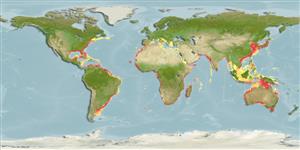Classification / Names
Common names from other countries
Main reference
Size / Weight / Age
Max length : 330 cm TL male/unsexed; (Ref. 27549); common length : 250 cm TL male/unsexed; (Ref. 6077); max. published weight: 158.8 kg (Ref. 40637)
Length at first maturity
Lm ?, range 220 - 230 cm
Environment
Marine; reef-associated; oceanodromous (Ref. 51243); depth range 1 - 191 m (Ref. 247), usually 15 - 25 m (Ref. 43278)
Climate / Range
Subtropical, preferred 26°C (Ref. 107945); 45°N - 48°S, 100°W - 155°E
Distribution
Circumtropical: Except perhaps the eastern Pacific (Ref. 13568). Indo-West Pacific: Red Sea and off the coasts of South Africa to Japan, Korea and Australia (Ref. 13568). Present in Arafura Sea (Ref. 9819). Western Atlantic: Gulf of Maine to Argentina. Old record from Bermuda, south Brazil (Ref. 26938). Eastern Atlantic: Mediterranean to Cameroon. Northwest Atlantic: Canada (Ref. 5951).
Countries | FAO areas | Ecosystems | Occurrences | Introductions
Short description
Dorsal
spines
(total): 0;
Dorsal
soft rays
(total): 0;
Anal
spines: 0;
Anal
soft rays: 0. A shark with a short, pointed snout, small eyes, protruding spike-like teeth and small, equal-sized dorsal and anal fins; 1st dorsal fin closer to pelvic than to pectoral fins (Ref. 5578). Caudal fin with a pronounced subterminal notch and a short ventral lobe (Ref. 13575). Pale brown or grey, paler below, with dark spots that appear faded in adults; fins plain (Ref. 6586).
IUCN Red List Status (Ref. 115185)
Threat to humans
Traumatogenic (Ref. 4690)
Human uses
Fisheries: commercial; gamefish: yes
More information
ReferencesAquacultureAquaculture profileStrainsGeneticsAllele frequenciesHeritabilityDiseasesProcessingMass conversion
Tools
Special reports
Download XML
Internet sources
Estimates of some properties based on models
Phylogenetic diversity index
PD50 = 0.8125 many relatives (e.g. carps) 0.5 - 2.0 few relatives (e.g. lungfishes)
Trophic Level
4.5 ±0.4 se; Based on diet studies.
Resilience
Very Low, minimum population doubling time more than 14 years (Fec=2; K=0.14-0.17; tmax=17)
Vulnerability
High vulnerability (58 of 100)
Price category
